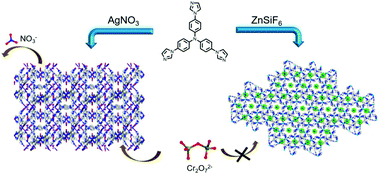Cationic metal–organic frameworks constructed from a trigonal imidazole-containing ligand for the removal of Cr2O72− in water†
Abstract
Recently, cationic metal–organic frameworks (MOFs) have drawn considerable attention in the treatment of wastewater containing toxic anions via anion exchange due to the presence of exchangeable anions in their pores. In this work, we employed the neutral imidazole-containing ligand tris(4-(1H-imidazol-1-yl)phenyl)amine (tipa) to construct two novel cationic MOFs, {[Ag3(tipa)2]4·[Ag(tipa)]·(NO3)13·2CH3CN·20H2O} (1) and {[Zn12(H2O)12(tipa)12(SiF6)9]·(SiF6)2·(OH)2·7CH3CN·64H2O} (2). Structural analysis revealed that complex 1 possessed 3D frameworks constructed from intercrossing 2D wavelike grids and highly disordered 1D chains with free NO3− in the channels, while 2 exhibited 3D frameworks composed of rotaxane-like subunits with free SiF62− and OH− anions filled in the channels. Subsequently, the anion-exchange properties of the two MOFs were examined with Cr2O72−, and the results suggest that only compound 1 exhibited adsorption capacity for Cr2O72− with high efficiency and recyclability.



 Please wait while we load your content...
Please wait while we load your content...